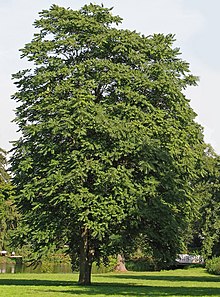Naming
Characteristics

Debug: Using Catalyst's built-in proxy configuration. Test URL: https://helpdesk.computersystemconsulting.ca/test
Naming |
|
|---|---|
| Botanical Name: | Ailanthus altissima (mill.) Sengle simaroubaceae |
| Common Names: | Tree-of-heaven, |
| Key Name: | Copal Tree |
| Parts Used: | Fresh or dried root and stem bark. |
| Sister Plants: | |
| Comments: | |
Characteristics |
|
| Identifying Character: | |
| Stem: | 10 -20 m; |
| Leaves: | 30 cm to 1 m long, subdevided into 11 -14 oblong, lanceolate or ovate, gland-baring leaflets. 7.5 to 11.5 cm long. |
| Flowers: | small, greenish in terminal paniles 10 - 20 cm, long |
| Fruit: | reddish-brown indihiscent winged called samara. |
| Taste: | |
| Odour: | |
| Root: | |
| Image URL: |

|
Distribution |
|
| Distribution: | Native to China naturalized to eastern North America |
| Cultivation: | Wild. Rapid growth resistance to pollution and desease easily grown from seed. |
| Harvest: | |
Medical |
|
| Therapeutic Action: | Antihaemorrhagic,Cathartic,Emetic |
| Medical Uses: | Dyusentery; Diarrhoea; Asthma; Epilepsy; Palpitations; Dueche in Gonorrheea and leucorrhoea; |
| Constituents: | Fixed ois, volitile oil. Gum; oleoresin; sugars; oxalic acid; possibly alkalois and glycocides. |
| Solvents: | |
| Dosage: | |
| Administration: | |
| Formulas: | |
| Contra Indications: | Unpleasent cousing nausea and vomiting and debility, and no longer used |
| Preparation: | |
| Chinese: | |
| Veterinary: | |
| Homeopathic: | |
Pollination and Pollinators |
|
| Apis: | No |
| Pollinator: | |
| Pollen: | No |
| Pollen Notes: | |
| Nectar: | No |
| Nectar Notes: | |
Other |
|
| Non-Medical Uses: | |
| Culinary Uses: | |
| History: | Introduced to England in 1751 from Nanking China, United States in 1800, popular ornimental. Medicinal value discovred in France in 1859. Ainlanthus is from Indonesia fro Tree of heave. Not used for eather varnish or copal. |
| Reference: | The Encyclopedia of Herbs and Herbalism< 11 |
| URL: | |
| Share: | Public |